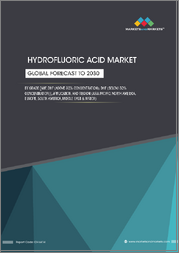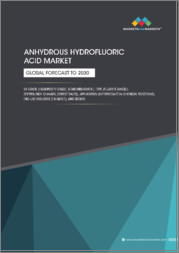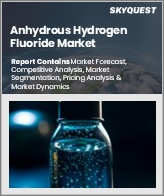
|
시장보고서
상품코드
1700120
헥사플루오로규산 시장 예측(-2032년) : 유형별, 농도 레벨별, 판매 채널별, 용도별, 최종사용자별, 지역별 세계 분석Hexafluorosilicic Acid Market Forecasts to 2032 - Global Analysis By Type (Liquid Hexafluorosilicic Acid, Powder Hexafluorosilicic Acid and Gas Hexafluorosilicic Acid), Concentration Level, Sales Channel, Application, End User and By Geography |
||||||
Stratistics MRC에 따르면 헥사플루오로규산 세계 시장은 2025년 11억 5,000만 달러로 예측 기간 동안 CAGR 6.8%로 성장하여 2032년에는 17억 5,000만 달러에 달할 것으로 예상됩니다.
헥사플루오로규산은 실리콘, 불소, 수소로 구성된 화합물입니다. 무색의 부식성 액체이며, 일반적으로 인광석 가공의 제품별로 생산됩니다. 헥사플루오로규산은 충치 예방을 위한 물의 불소화와 알루미늄 제조 및 특정 화학제품의 제조와 같은 산업 공정에서 일반적으로 사용됩니다.
조사에 따르면 중국과 인도가 형석의 주요 생산국이며 2020년 생산량은 각각 430만 톤과 120만 톤입니다.
수돗물 불소화 프로그램 도입 증가
세계 각국의 정부와 공중보건기관이 충치 예방에 있어 불소 첨가 물의 중요성을 인식함에 따라, 불소 첨가 프로그램을 시행하는 지역이 증가하고 있습니다. 이러한 추세는 치과 치료에 대한 접근성이 제한된 개발도상국에서 특히 두드러지게 나타나고 있습니다. 식수에 불소를 첨가하기 위한 헥사플루오로규산의 필요성은 지속적인 시장 수요를 창출하고 있습니다. 또한, 구강 건강에 대한 불소의 이점에 대한 대중의 인식 개선 캠페인은 이러한 프로그램의 확장을 더욱 촉진하여 시장의 꾸준한 성장을 보장합니다.
환경 문제와 건강 위험
헥사플루오로규산은 적절히 취급하지 않거나 폐기하지 않으면 물과 토양을 오염시킬 수 있어 환경오염의 우려가 있습니다. 높은 독성은 생태계를 손상시키고 수생 생물에 영향을 미칠 수 있습니다. 건강 위험으로는 피부, 눈, 호흡기 계통에 자극을 줄 수 있으며, 장기간 노출되면 더 심각한 건강 문제를 일으킬 수 있습니다. 이러한 우려는 엄격한 규제 조치와 안전 비용 상승으로 이어져 시장 성장을 제한하고 있습니다.
신흥국의 구강 위생에 대한 인식 제고
개발도상국 사람들이 불소와 치아 건강의 연관성을 인식함에 따라 정부와 보건 기관은 충치 유병률을 낮추고 전반적인 구강 위생을 개선하기 위해 수돗물 불소화 프로그램을 채택하고 있습니다. 이러한 인식은 수처리 시스템에서 헥사플루오로규산의 필요성을 증가시켰습니다. 또한, 가처분 소득의 증가와 라이프스타일의 변화는 구강 관리 수요에 더욱 기여하고 있으며, 이들 지역에서 시장이 확대될 수 있는 유리한 환경을 조성하고 있습니다.
대체 불소화 방법
헥사플루오로규산의 대체 불소화 방법으로는 불화나트륨(NaF), 불화규산나트륨(Na2SiF6), 불화칼슘(CaF2) 등이 있습니다. 이러한 대체품은 취급이 용이하고 독성이 낮으며 규제 당국의 승인이 더 잘 확립되어 있기 때문에 선호되는 경우가 많습니다. 그 결과, 지자체와 산업계는 이러한 대안을 선택하게 되고, 헥사플루오로규산의 수요가 감소하게 됩니다. 이러한 대체품의 가용성으로 인해 보다 안전하고 비용 효율적인 대안이 제공되어 헥사플루오로규산 시장의 성장을 저해하고 있습니다.
COVID-19의 영향
COVID-19 사태는 헥사플루오로규산 시장에 큰 영향을 미쳐 공급망과 생산 시설에 혼란을 일으켰습니다. 지방 자치 단체의 예산이 삭감되고 긴급한 보건 우선 순위가 강조되면서 수돗물 불소화에 대한 수요가 일시적으로 영향을 받았습니다. 그러나 공중 보건 캠페인이 재개되고 치과 치료의 중요성이 강조되면서 시장이 회복되었습니다. 일시적인 후퇴가 있었지만, 전 세계적으로 도시화와 수처리에 대한 노력이 진행되고 있기 때문에 장기적인 성장 전망은 여전히 밝습니다.
예측 기간 동안 액체 헥사플루오로규산 부문이 가장 큰 부문이 될 것으로 예상됩니다.
예측 기간 동안 액체 헥사플루오로규산 부문이 가장 큰 시장 점유율을 차지할 것으로 예상됩니다. 액체 헥사플루오로규산은 실리콘, 불소, 수소로 구성된 부식성이 강한 무색의 액체입니다. 불소를 공공 수돗물에 첨가하여 충치를 예방하기 위해 주로 수돗물 불소화에 사용됩니다. 또한 알루미늄 제조, 화학 제조, 섬유 가공 등 산업 공정에서도 중요한 역할을 하고 있습니다. 또한 불순물을 제거하여 식수 정화에도 도움이 됩니다.
예측 기간 동안 화학 합성 부문은 가장 높은 CAGR을 보일 것으로 예상됩니다.
예측 기간 동안 화학 합성 부문이 가장 높은 성장률을 보일 것으로 예상됩니다. 화학 합성에서 헥사플루오로규산은 불소화제로서 다양한 불소 화합물의 제조에 사용됩니다. 헥사플루오로규산은 농약, 의약품, 윤활유 등 특수 화학제품의 제조에 중요한 중간체인 플루오로실리케이트의 합성에 중요한 역할을 합니다. 유기 분자에 불소를 도입하는 능력이 있기 때문에 화학 반응의 강화, 특히 고성능 재료의 제조에 유용합니다.
가장 큰 점유율을 차지하는 지역
예측 기간 동안 아시아태평양은 도시화, 산업화, 정부 주도의 수돗물 불소화 프로그램의 증가로 인해 가장 큰 시장 점유율을 차지할 것으로 예상됩니다. 중국, 인도, 일본과 같은 국가들이 주요 소비국이며, 치아 건강에 대한 인식이 높아짐에 따라 불소 첨가 수돗물 수요가 증가하고 있습니다. 알루미늄 생산 및 화학 제조의 산업적 용도도 시장 성장에 기여하고 있습니다. 또한, 수처리 솔루션 및 불소 기반 제품에 대한 수요가 이 지역의 성장을 유지할 것으로 예상됩니다.
CAGR이 가장 높은 지역
예측 기간 동안 북미는 특히 미국과 캐나다에서 지역 보건 이니셔티브가 치과 치료를 우선시함에 따라 수돗물 불소화 프로그램에 대한 강력한 수요에 힘입어 가장 높은 CAGR을 보일 것으로 예상됩니다. 수처리에 대한 엄격한 규제와 함께 구강 위생에 대한 인식이 높아짐에 따라 시장 확대에 기여하고 있습니다. 또한, 공중 보건 및 산업적 요구로 인해 시장은 꾸준히 성장하고 있습니다.
무료 커스터마이징 서비스
본 보고서를 구독하는 고객은 다음과 같은 무료 맞춤화 옵션 중 하나를 이용할 수 있습니다.
- 기업 소개
- 추가 시장 진입 기업의 종합적인 프로파일링(최대 3개사까지)
- 주요 기업 SWOT 분석(3개사까지)
- 지역 세분화
- 고객의 관심에 따른 주요 국가별 시장 추정 및 예측, CAGR(주: 타당성 검토에 따른)
- 경쟁사 벤치마킹
- 제품 포트폴리오, 지리적 입지, 전략적 제휴를 통한 주요 기업 벤치마킹
목차
제1장 주요 요약
제2장 서문
- 개요
- 이해관계자
- 조사 범위
- 조사 방법
- 데이터 마이닝
- 데이터 분석
- 데이터 검증
- 조사 접근법
- 조사 자료
- 1차 조사 자료
- 1차 조사 자료
- 가정
제3장 시장 동향 분석
- 소개
- 성장 촉진요인
- 성장 억제요인
- 기회
- 위협
- 용도 분석
- 최종사용자 분석
- 신흥 시장
- COVID-19의 영향
제4장 Porter's Five Forces 분석
- 공급 기업의 교섭력
- 구매자의 교섭력
- 대체품의 위협
- 신규 참여업체의 위협
- 경쟁 기업 간의 경쟁 관계
제5장 세계의 헥사플루오로규산 시장 : 유형별
- 소개
- 액체 헥사플루오로규산
- 분말 헥사플루오로규산
- 가스 헥사플루오로규산
제6장 세계의 헥사플루오로규산 시장 : 농도 레벨별
- 소개
- 25%-35%
- 35%-45%
- 45% 이상
제7장 세계의 헥사플루오로규산 시장 : 유통 채널별
- 소개
- E-Commerce 플랫폼
- 화학제품 공급점
- 판매대리점과 도매업체
- 기타
제8장 세계의 헥사플루오로규산 시장 : 용도별
- 소개
- 수돗물 불소화
- 화학 합성
- 금속 표면 치료
- 전기도금과 아연도금
- 유리 에칭과 프로스팅
- 섬유와 피혁 치료
- 기타
제9장 세계의 헥사플루오로규산 시장 : 최종사용자별
- 소개
- 석유 및 가스 산업
- 농업
- 건축·건설
- 의약품
- 일렉트로닉스와 반도체
- 기타
제10장 세계의 헥사플루오로규산 시장 : 지역별
- 소개
- 북미
- 미국
- 캐나다
- 멕시코
- 유럽
- 독일
- 영국
- 이탈리아
- 프랑스
- 스페인
- 기타 유럽
- 아시아태평양
- 일본
- 중국
- 인도
- 호주
- 뉴질랜드
- 한국
- 기타 아시아태평양
- 남미
- 아르헨티나
- 브라질
- 칠레
- 기타 남미
- 중동 및 아프리카
- 사우디아라비아
- 아랍에미리트
- 카타르
- 남아프리카공화국
- 기타 중동 및 아프리카
제11장 주요 개발
- 계약, 파트너십, 협업, 합작투자
- 인수와 합병
- 신제품 발매
- 사업 확대
- 기타 주요 전략
제12장 기업 개요
- Solvay S.A.
- American Elements
- Honeywell International Inc.
- Gelest Inc.
- Graham Chemical
- FUJIFILM Wako Pure Chemical Corporation
- Ensince Industry Co., Ltd.
- Hebei Chuanghai BIoTechnology Co., Ltd.
- RX Chemicals
- Henan Tianfu Chemical Co., Ltd.
- Chemiewerk Bad Kostritz GmbH
- AGC Chemicals Europe, Ltd.
- Moller Chemie GmbH & Co. KG
- SIMAGCHEM Corporation
According to Stratistics MRC, the Global Hexafluorosilicic Acid Market is accounted for $1.15 billion in 2025 and is expected to reach $1 .75 billion by 2032 growing at a CAGR of 6.8% during the forecast period. Hexafluorosilicic acid is a chemical compound composed of silicon, fluorine, and hydrogen. It is a colorless, corrosive liquid typically produced as a byproduct of phosphate rock processing. Hexafluorosilicic acid is commonly used in water fluoridation to prevent dental decay, as well as in industrial processes like the production of aluminum and the manufacture of certain chemicals.
According to research, China and India are the major fluorspar producers, with 4.3 million tonnes and 1.2 million tonnes produced in 2020 respectively.
Market Dynamics:
Driver:
Increasing adoption of water fluoridation programs
As governments and public health organizations globally recognize the importance of fluoridated water in preventing dental decay, more communities implement these programs. This trend is particularly prominent in developing regions where access to dental care may be limited. The need for hexafluorosilicic acid to fluoridate drinking water results in a consistent market demand. Additionally, public awareness campaigns on the benefits of fluoride in oral health further support the expansion of these programs, ensuring steady market growth.
Restraint:
Environmental concerns and health risks
Hexafluorosilicic Acid poses environmental concerns due to its potential to contaminate water and soil if not handled or disposed of properly. Its high toxicity can lead to ecological damage, affecting aquatic life. Health risks include irritation of the skin, eyes, and respiratory system, with long-term exposure causing more severe health issues. These concerns lead to stringent regulatory measures and higher safety costs, limiting the market's growth.
Opportunity:
Growing awareness regarding oral health in developing countries
As people in developing countries become more aware of the link between fluoride and dental health, governments and health organizations are adopting water fluoridation programs to reduce the prevalence of dental cavities and improve overall oral hygiene. This awareness boosts the need for hexafluorosilicic acid in water treatment systems. Additionally, rising disposable incomes and changing lifestyles further contribute to the demand for oral care, creating a favorable environment for the market to expand in these regions.
Threat:
Alternative fluoridation methods
Alternative fluoridation methods to hexafluorosilicic acid include sodium fluoride (NaF), sodium fluorosilicate (Na2SiF6), and calcium fluoride (CaF2). These alternatives are often preferred due to their easier handling, lower toxicity, and more established regulatory approval. As a result, municipalities and industries may opt for these alternatives, reducing demand for hexafluorosilicic acid. The availability of these alternatives hampers the hexafluorosilicic acid market growth by offering safer, more cost-effective options.
Covid-19 Impact:
The covid-19 pandemic significantly impacted the Hexafluorosilicic Acid market, causing disruptions in supply chains and production facilities. The demand for water fluoridation was temporarily affected due to reduced municipal budgets and focus on urgent health priorities. However, the market saw a rebound as public health campaigns resumed, emphasizing the importance of dental care. Despite temporary setbacks, the long-term growth outlook remains positive due to ongoing urbanization and water treatment initiatives globally.
The liquid hexafluorosilicic acid segment is expected to be the largest during the forecast period
The liquid hexafluorosilicic acid segment is expected to account for the largest market share during the forecast period. Liquid Hexafluorosilicic Acid is a highly corrosive, colorless liquid composed of silicon, fluorine, and hydrogen. It is primarily used in water fluoridation to prevent dental cavities by adding fluoride to public water supplies. It also plays a vital role in industrial processes, such as the production of aluminum, chemical manufacturing, and textile processing. Additionally, it helps in the purification of drinking water by removing impurities.
The chemical synthesis segment is expected to have the highest CAGR during the forecast period
Over the forecast period, the chemical synthesis segment is predicted to witness the highest growth rate. In chemical synthesis, hexafluorosilicic acid is used as a fluorinating agent in the production of various fluorine-based compounds. It plays a crucial role in the synthesis of fluorosilicates, which are key intermediates in the manufacturing of specialty chemicals, such as pesticides, pharmaceuticals, and lubricants. Its ability to introduce fluorine into organic molecules makes it valuable in enhancing chemical reactions, particularly in the production of high-performance materials.
Region with largest share:
During the forecast period, the Asia Pacific region is expected to hold the largest market share due to increasing urbanization, industrialization, and government-driven water fluoridation programs. Countries like China, India, and Japan are the key consumers, with rising awareness about dental health driving demand for fluoridated water. Industrial applications in aluminum production and chemical manufacturing also contribute to the market's growth. Further, the demand for water treatment solutions and fluoride-based products is expected to sustain growth in the region.
Region with highest CAGR:
Over the forecast period, the North America region is anticipated to exhibit the highest CAGR driven by strong demand for water fluoridation programs, particularly in the United States and Canada, where community health initiatives prioritize dental care. Growing awareness of oral health, alongside stringent regulations on water treatment, supports market expansion. Further, the market continues to see steady growth due to public health and industrial needs.
Key players in the market
Some of the key players in Hexafluorosilicic Acid Market include Solvay S.A., American Elements, Honeywell International Inc., Gelest Inc., Graham Chemical, FUJIFILM Wako Pure Chemical Corporation, Ensince Industry Co., Ltd., Hebei Chuanghai Biotechnology Co., Ltd., RX Chemicals, Henan Tianfu Chemical Co., Ltd., Chemiewerk Bad Kostritz GmbH, AGC Chemicals Europe, Ltd., Moller Chemie GmbH & Co. KG and SIMAGCHEM Corporation.
Key Developments:
In August 2024, Honeywell and Repsol announced a strategic collaboration aimed at developing innovative production pathways for biofuels and circular materials. This partnership focuses on integrating Honeywell's advanced technologies into Repsol's existing facilities to enhance sustainable fuel production and recycling efforts.
In June 2023, IXOM, a global leader in water treatment and chemical solutions, introduced a new line of fluorosilicic acid products specifically designed for the textile processing industry. This strategic move highlights IXOM's commitment to expanding its product portfolio to meet the specialized needs of textile manufacturers.
Types Covered:
- Liquid Hexafluorosilicic Acid
- Powder Hexafluorosilicic Acid
- Gas Hexafluorosilicic Acid
Concentration Levels Covered:
- 25%-35%
- 35%-45%
- Above 45%
Sales Channels Covered:
- E-commerce Platforms
- Chemical Supply Stores
- Distributors & Wholesalers
- Other Sales Channels
Applications Covered:
- Water Fluoridation
- Chemical Synthesis
- Metal Surface Treatment
- Electroplating & Galvanizing
- Glass Etching & Frosting
- Textile & Leather Treatment
- Other Applications
End Users Covered:
- Oil & Gas Industry
- Agriculture
- Building & Construction
- Pharmaceuticals
- Electronics & Semiconductors
- Other End Users
Regions Covered:
- North America
- US
- Canada
- Mexico
- Europe
- Germany
- UK
- Italy
- France
- Spain
- Rest of Europe
- Asia Pacific
- Japan
- China
- India
- Australia
- New Zealand
- South Korea
- Rest of Asia Pacific
- South America
- Argentina
- Brazil
- Chile
- Rest of South America
- Middle East & Africa
- Saudi Arabia
- UAE
- Qatar
- South Africa
- Rest of Middle East & Africa
What our report offers:
- Market share assessments for the regional and country-level segments
- Strategic recommendations for the new entrants
- Covers Market data for the years 2024, 2025, 2026, 2028, and 2032
- Market Trends (Drivers, Constraints, Opportunities, Threats, Challenges, Investment Opportunities, and recommendations)
- Strategic recommendations in key business segments based on the market estimations
- Competitive landscaping mapping the key common trends
- Company profiling with detailed strategies, financials, and recent developments
- Supply chain trends mapping the latest technological advancements
Free Customization Offerings:
All the customers of this report will be entitled to receive one of the following free customization options:
- Company Profiling
- Comprehensive profiling of additional market players (up to 3)
- SWOT Analysis of key players (up to 3)
- Regional Segmentation
- Market estimations, Forecasts and CAGR of any prominent country as per the client's interest (Note: Depends on feasibility check)
- Competitive Benchmarking
- Benchmarking of key players based on product portfolio, geographical presence, and strategic alliances
Table of Contents
1 Executive Summary
2 Preface
- 2.1 Abstract
- 2.2 Stake Holders
- 2.3 Research Scope
- 2.4 Research Methodology
- 2.4.1 Data Mining
- 2.4.2 Data Analysis
- 2.4.3 Data Validation
- 2.4.4 Research Approach
- 2.5 Research Sources
- 2.5.1 Primary Research Sources
- 2.5.2 Secondary Research Sources
- 2.5.3 Assumptions
3 Market Trend Analysis
- 3.1 Introduction
- 3.2 Drivers
- 3.3 Restraints
- 3.4 Opportunities
- 3.5 Threats
- 3.6 Application Analysis
- 3.7 End User Analysis
- 3.8 Emerging Markets
- 3.9 Impact of Covid-19
4 Porters Five Force Analysis
- 4.1 Bargaining power of suppliers
- 4.2 Bargaining power of buyers
- 4.3 Threat of substitutes
- 4.4 Threat of new entrants
- 4.5 Competitive rivalry
5 Global Hexafluorosilicic Acid Market, By Type
- 5.1 Introduction
- 5.2 Liquid Hexafluorosilicic Acid
- 5.3 Powder Hexafluorosilicic Acid
- 5.4 Gas Hexafluorosilicic Acid
6 Global Hexafluorosilicic Acid Market, By Concentration Level
- 6.1 Introduction
- 6.2 25%-35%
- 6.3 35%-45%
- 6.4 Above 45%
7 Global Hexafluorosilicic Acid Market, By Sales Channel
- 7.1 Introduction
- 7.2 E-commerce Platforms
- 7.3 Chemical Supply Stores
- 7.4 Distributors & Wholesalers
- 7.5 Other Sales Channels
8 Global Hexafluorosilicic Acid Market, By Application
- 8.1 Introduction
- 8.2 Water Fluoridation
- 8.3 Chemical Synthesis
- 8.4 Metal Surface Treatment
- 8.5 Electroplating & Galvanizing
- 8.6 Glass Etching & Frosting
- 8.7 Textile & Leather Treatment
- 8.8 Other Applications
9 Global Hexafluorosilicic Acid Market, By End User
- 9.1 Introduction
- 9.2 Oil & Gas Industry
- 9.3 Agriculture
- 9.4 Building & Construction
- 9.5 Pharmaceuticals
- 9.6 Electronics & Semiconductors
- 9.7 Other End Users
10 Global Hexafluorosilicic Acid Market, By Geography
- 10.1 Introduction
- 10.2 North America
- 10.2.1 US
- 10.2.2 Canada
- 10.2.3 Mexico
- 10.3 Europe
- 10.3.1 Germany
- 10.3.2 UK
- 10.3.3 Italy
- 10.3.4 France
- 10.3.5 Spain
- 10.3.10 Rest of Europe
- 10.4 Asia Pacific
- 10.4.1 Japan
- 10.4.2 China
- 10.4.3 India
- 10.4.4 Australia
- 10.4.5 New Zealand
- 10.4.10 South Korea
- 10.4.7 Rest of Asia Pacific
- 10.5 South America
- 10.5.1 Argentina
- 10.5.2 Brazil
- 10.5.3 Chile
- 10.5.4 Rest of South America
- 10.6 Middle East & Africa
- 10.6.1 Saudi Arabia
- 10.6.2 UAE
- 10.6.3 Qatar
- 10.6.4 South Africa
- 10.6.5 Rest of Middle East & Africa
11 Key Developments
- 11.1 Agreements, Partnerships, Collaborations and Joint Ventures
- 11.2 Acquisitions & Mergers
- 11.3 New Product Launch
- 11.4 Expansions
- 11.5 Other Key Strategies
12 Company Profiling
- 12.1 Solvay S.A.
- 12.2 American Elements
- 12.3 Honeywell International Inc.
- 12.4 Gelest Inc.
- 12.5 Graham Chemical
- 12.6 FUJIFILM Wako Pure Chemical Corporation
- 12.7 Ensince Industry Co., Ltd.
- 12.8 Hebei Chuanghai Biotechnology Co., Ltd.
- 12.9 RX Chemicals
- 12.10 Henan Tianfu Chemical Co., Ltd.
- 12.11 Chemiewerk Bad Kostritz GmbH
- 12.12 AGC Chemicals Europe, Ltd.
- 12.13 Moller Chemie GmbH & Co. KG
- 12.14 SIMAGCHEM Corporation



















